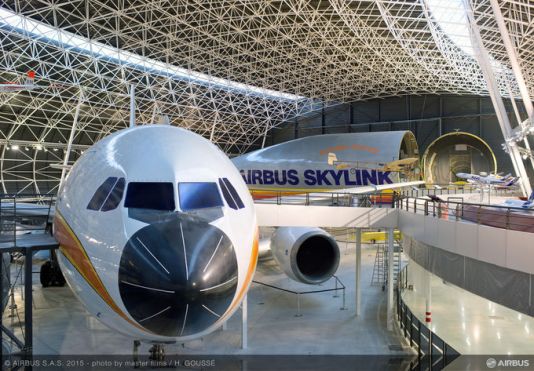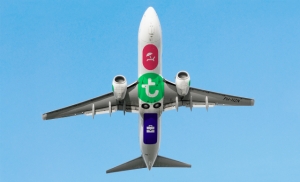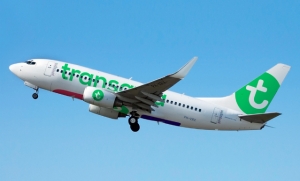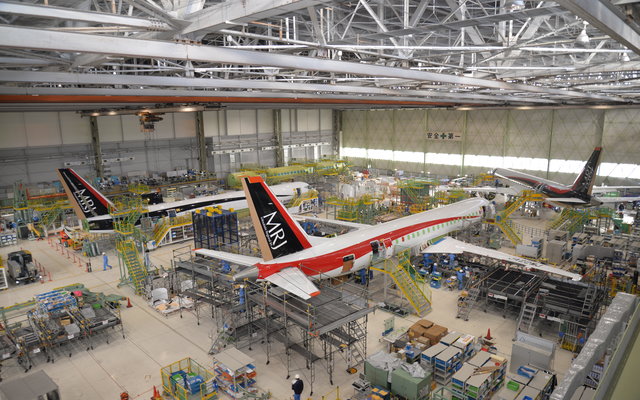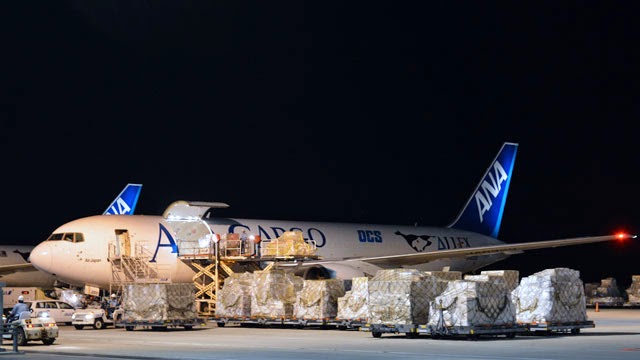ON THE BOEING FRONT
GE Gears Up for Engine Tests of GE9X Parts
GE Aviation will shortly begin running a test engine equipped with a number of advanced-technology components that will feature on the GE9X powerplant destined for the Boeing 777X.
The parts include combustor liners, high-pressure turbine shrouds and nozzles made from ceramic matrix composite (CMC), next generation high-pressure turbine blades, and titanium-aluminide low-pressure turbine blades produced via additive layer manufacturing.
Set to get under way in the coming weeks at GE’s facility in Peebles, Ohio, the trials will be conducted using a GEnx test engine fitted with the new Parts.
GE is already utilizing CMCs for the high-pressure turbine shroud on the CFM International LEAP engines in partnership with Snecma, but the GE9X dramatically expands their deployment.
Meanwhile, tests will shortly commence on a second iteration of the compressor. These will be carried in Massa in Ital where GE has an oil and gas business and that is ready to fire up in the next week or so.
The CMC components are around 25% lighter than their metallic equivalents, says Matt Szolwinski head of the GE9X program, and additionally able to withstand much higher temperatures without the need for cooling.
First flight of the 105,000lb-thrust powerplant is scheduled for 2017 aboard GE’s 747-400 test aircraft.
Certification should follow around a year later.
Source : Flightglobal/GE Aviation
ON THE AIRBUS FRONT
A New Attraction in Toulouse For Aviation Enthusiasts: The Aeroscopia Museum Opens
Aeroscopia is located adjacent to Toulouse-Blagnac Airport, putting it in proximity to Airbus’ home location-including the company’s headquarters and its A380, A350XWB, A330 and A320 Family final assembly lines. This enables visitors to look at Airbus’ current production activity while exploring aviation history at Aerscopia.
The museum features a collection of iconic aircraft displayed in its exhibition hall and paved grounds, including an A300B the landmark widebody twin-engine jetliner that launched Airbus-a “Super Guppy” outsized transporter used by Airbus to carry aircraft components during the company’s early days, and an Aerospatiale-BAC Concorde supersonic passenger airliner.
“Airbus’ contribution to Aeroscopia reflects the company’s great fondness for celebrating its roots and different phases of aircraft development and production over the years,” said Jacques Rocca, Airbus’ Deputy Head of Media Relations and Heritage, who also is a member of the museum’s technical committee.
Manatour, the company that offers tours of Airbus’ final assembly lines in Toulouse, manages Aeroscopia as well, Rocca explained, proving an exciting “two-faceted” experience for aviation buffs- with all tours of Airbus’ Toulouse production facilities now starting at the museum.
Source : Airbus/Airbus Photo
BUSINESS/REGIONAL NEWS
NetJets Europe Cleared to Fly Phenom 300s from London City Airport
NetJets Europe has clinched approval from the UK Civil Aviation Authority to Operate its Embraer Phenom 300 light cabin business jet at London City airport, in the heart of the UK’s financial community.
The Berkshire Hathaway-owned company is the largest operator at the site, responsible for over 50% of all business aircraft traffic. In 2014 alone, NetJET says it flew from City to over 370 destinations worldwide, with Paris Le Bourget one of the most popular routes.
NetJets placed an order in 2010 for 125 Phenom 300s-including 60 firm orders as part of a $17.6 billion order. The Operator has taken delivery of 35 of the seven-seat twinjets, five of which are based in Europe.
Source: Flightglobal/Photo Net Jets Europe
OTHER AVIATION NEWS
Delta is Bringing the Boeing 717 Back Home to California
Delta is upgrading its fleet on the Los Angeles to San Francisco shuttle, one of the most competitive routes in the country, by replacing most of its regional jets with the Boeing 717, an aircraft that never quite caught on but seems well-suited to this particular market. In a sense, the 717s will be coming home to where they where originally built.
Delta said it will introduce the 717s on eight of its 15 daily flights between California’s two biggest airports.
The 717s were the last commercial airplanes produced at the Long Beach, California plant that Boeing acquired when it merged with McDonnell Douglas in 1997. Boeing made 156 of them, closing out with a 2006 delivery to AirTran, which became the biggest customer for the 100 seat aircraft.
Delta announced in 2013 that it would take over the leases for AirTran’s 88 Boeing 717s from Southwest, which acquired AirTran but then decided it wanted to stick with a single fleet type, the 737. So far Delta has acquired 54 of the 717s.
Source: Ed’s Research
CFM Starts Leap-1A Flight Tests
CFM International has begun flight tests of its new Leap-1A engine destined for the Airbus A320neo narrowbody, the GE Aviation-Snecma venture confirms.
A modified Boeing 747-400 owned by GE is being used for trials of the 24,500-32,900-lb-thrust turbofan, which are taking place at Victorville, California.
It is the second of the Leap-series engines to take to the skies, following the maiden flight of the-1C for the Comac C919 in October 2014.
The -1B for the 737 Max will fly later this year, with assembly work on the initial flight -test engine under way at GE’s facility in Evendale, Ohio. Of the three Leap engines, the -1A and the -1C are broadly similar while the -1B is slightly smaller. The latter features a 69.5 in (176.5cm) fan with a 9.1 bypass ratio, against figures of 78 in and 11:1 for the -1 and-1C.
So far, CFM has conducted engine runs totaling 1,940h across 3,360 cycles using all three engine variants. It aims to have achieved 40,000h by service entry of the Leap-1A next year and 60,000h by the time the-1C enters service in 2018.
Source : GE Aviation-Snecma/Flightglobal
Scoot Takes Delivery of its First 787-9
Singapore-based low-cost carrier Scoot has taken delivery of its first Boeing 787-9 during a ceremony held at Boeing’s delivery center in Everett.
Scoot is a subsidiary of Singapore Airlines. The aircraft, registered as 9V-OJA and named “ Dream Start” (MSN 37112), departed Everett on January 31st, arriving in Singapore on the Morning of February 2nd. It entered commercial service on February 5th flying from Singapore to Perth and Hong Kong.
Scoot’s 787-9s are configured with 375 seats, comprised of 340 economy-class seats and 35 premium seats. They are powered by Rolls-Royce Trent 1000 engines. The airline plans to take delivery of six 787-9s by August, which will replace its fleet of six 777-200s. In addition, it will take three 787-8s by the end of the year, and plans to have an all 787 fleet of 11 aircraft by March 2016.Thereafter, the carrier will take delivery of two or three aircraft per year until early 2019, when it will have received all 20 on order.
Scoot chief executive Campbell Wilson says that the new aircraft is a major benefit to the airline’s long term strategy.
Source : Flightglobal / Boeing Photos
LATEST NEWS IN BRIEF
- COMAC (Commercial Aircraft of China) has received an order for 20 C919s from Huaxia Financial Leasing company.
- Chorus Aviation Canadian regional carrier has placed a firm order for 13 Bombardier Q400 turboprops worth $424 million after signing an amended capacity purchase agreement with Air Canada.
- Transavia Air France-KLM Group’s low-cost operator ordered up to 20 Boeing 737-800s and revealed a new livery.
- Asiana Airlines has signed a letter of intent(LOI) with Airbus for the purchase of 25 A321neo single aisle aircraft as part of its ongoing fleet modernization program.
- Bombardier has completed flutter, cold weather and passenger-evacuation testing as CSeries flight tests pass the 900-hour mark enroute to the 2,400 hours required for certification.
- Korean Air has ordered five Boeing 777-200 LR Freighters in a deal worth $1.5 billion at List prices.
- Luxair to acquire more Q400s under a fleet renewal plan to increase capacity.
- Airbus has officially written off the order for the first, and so far only,VVIP 380. Saudi prince Alwaleed bin Talal bin Abdulaziz Alsaud placed the order in 2007.
- Greenpoint Technologies has delivered the first BBJ 747-8, thus becoming the first outfitter to hand over an executive version of Boeing’s newest four-engine widebody.
- Mitsubishi Aircraft has released pictures of its flight test fleet in various stages of final assembly.
AIR CARGO
ANA & United Form Trans-Pacific Cargo Joint Venture
On December 1st, 2014 All Nippon Airways (ANA) and Lufthansa Cargo launched their Europe/Asia joint venture with first flights from Japan to Europe. And with that deal under its belt, ANA has turned its focus to the trans-Pacific lane, signing a similar agreement with US-based United Airlines.
The two carriers have filed antitrust exemption applications with US and Japanese regulatory authorities for a set up similar to ANA’s Joint Venture with Lufthansa Cargo.
Commenting on the filing, ANA described the proposal Joint Venture with United as one that would “create a more efficient and comprehensive trans-Pacific air cargo business network”. The carrier went on to say that trans-Pacific cargo Joint venture-the first of its kind between The US and Asia-would generate substantial service benefits for freight customers, and that “it would also enable United and ANA to compete more efficiently with other airlines that maintain a significant presence in both markets.”
As with Lufthansa Cargo agreement, under the proposed United agreement the two carriers “will be able to jointly manage trans-Pacific air cargo business activities including scheduling, pricing and sales.”
Like Lufthansa and ANA, United is a member of the Star Alliance, and if the trans-Pacific venture gains regulatory approval it could start of a broader Star Cargo Alliance. It will be interesting to see what happens.
In addition to a long-haul passenger fleet that includes fifty-four 777s and thirty-three 787s (with more on order), ANA operates ten 767-300Fs intra-Asia regional service. United does not operate freighters, but has a large fleet of wide body passenger aircraft, including seventy-four 777s and thirteen 787s (with more on order).
Source: CargoFact/ANA
The Great French-fry Airlift
Never let it be said that the airfreight industry will back down from a daunting humanitarian challenge. From any region of the globe, heroic cargo carriers can step up when needed to transport emergency medicines, shelters, fuel, personnel and … French fries?
Well, it’s not exactly on par with the Berlin Airlift, but air cargo companies have helped the nation of Japan end a crippling McDonald’s French fry shortage that had ravaged the country’s super-sized appetite for three weeks. The shortage, which forced the 3,100 McDonald’s restaurants in Japan to ration its dwindling fry supply and offer only small-sized portions since mid-December, finally ended to thanks to an emergency shipment of about 2,600 tons of frozen French fries in late December 2014.
According to a statement from McDonald’s Japan, the shortage arose from the ongoing slowdown due to labor dispute at seaports along the U.S. West Coast, which caused lengthy delays in the shipment of the restaurant chain’s signature side-dish in late 2014.
McDonald’s Japan also said about 1,000 tons of fries were sent via airfreight from East Coast ports and another 1,600 tons were shipped by seafreight. Beginning on Jan. 5, 2015, the small-size limit was removed at all locations and customers are again free to order large portions.
No information was provided about which air cargo carriers were used in the “airlift” or how much the shortage has affected sales for the restaurant giant’s Japanese operations.
While the island nation also grows some potatoes on its own, most of those are prepared and eaten fresh, the Associated Press reported. Most of the 300,000 short tons of French fries consumed each year in Japan are imported in pre-cut frozen form.
While the restrictions have been lifted, McDonald’s Japan cautioned its customers that the emergency shipment may not be enough to meet demand. “We will continue to monitor the situation carefully to do our best to ensure stable supply of potato products,” the company added.
Source: Air Cargo World
Researched and Compiled by : Ed Kaplanian
Commercial Aviation Advisor
Contact – ed@kaplanianreport.com


